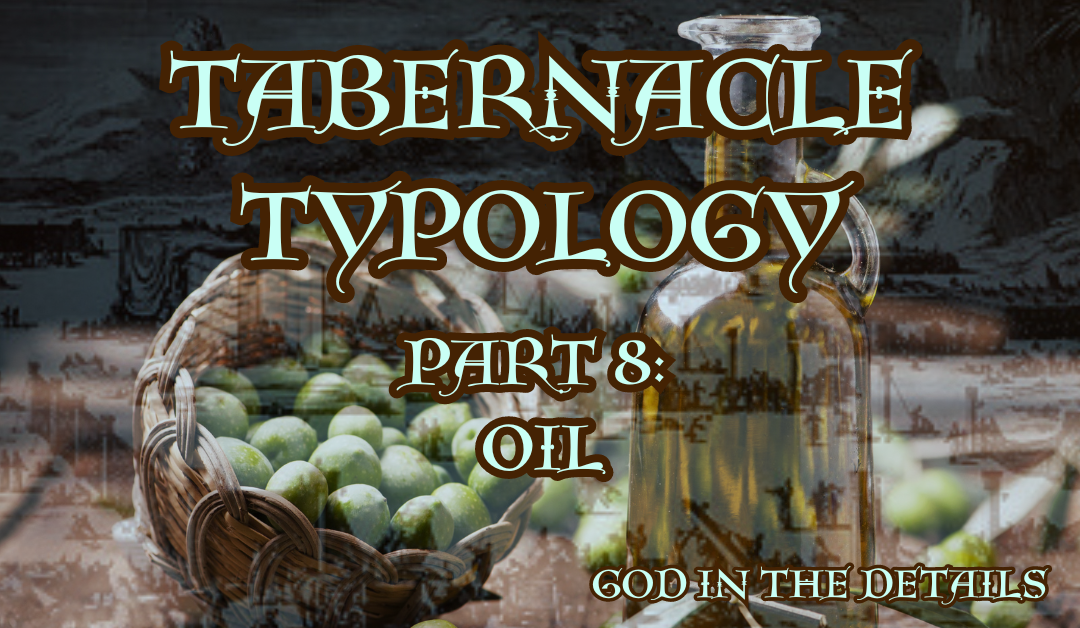
Tabernacle Typology 9: Spices
Exodus 30:23-25, KJV:
“Take thou also unto thee principal spices, of pure myrrh five hundred shekels, and of sweet cinnamon half so much, even two hundred and fifty shekels, and of sweet calamus two hundred and fifty shekels, And of cassia five hundred shekels, after the shekel of the sanctuary, and of oil olive an hin: And thou shalt make it an oil of holy ointment, an ointment compound after the art of the apothecary: it shall be an holy anointing oil.”
In the previous reading we looked at the use and the significance of olive oil in the Tabernacle – how it was used as fuel for the lamps – but also for the production of anointing oil.
This time we will look at the 4 spices included in the anointing oil.
The four spices are: Myrrh, Cinnamon, Calamus and Cassia.
Myrrh: Myrrh has been used throughout the ages for medicine and perfumery. It is a sweet smelling substance and bitter to the taste. It is closely related to frankincense and comes from the same family of woody, flowering plants.
It is extracted by repeatedly wounding the trees until they ‘bleed’ the myrrh gum.
In medicine it is used as an antiseptic in toothpastes, gargles and mouthwashes. It is also used in salves for abrasions and as a pain-reliever in ointments. It has also been said to be helpful in relieving the symptoms of arthritis among other things.
In ancient times myrrh was used as a tincture to alleviate the suffering of the dying. Jesus, on the cross, was offered myrrh mixed with wine for the pain, but He refused.
The trees were ‘bled’ to procure the oil, ‘wounded’ to get the healing balm. Christ was wounded for our transgressions and pierced for our iniquities – for the Healing Balm of His Blood to flow.
Fragrant Cinnamon: Cinnamon is obtained from the bark of trees belonging to the Cinnamomum family.
It is used to add flavor to both sweet and savoury dishes – breakfast, lunch and dinner – and has a lot of health benefits.
In Ancient Times it was considered very rare and costly. According to Pliny the Elder a Roman pound (more or less 327 grams) cost about 50 months of labor (or 1500 denarii). It was often given to kings and emperors as gifts, and even offered as tribute to their pagan gods.
In the body it reduces inflammation and is also good for your heart health. It is considered a heart stimulant because it increases blood flow. It can stimulate a weak heart.
Our hearts might’ve been weak before – but with the death and resurrection of our Lord we are encouraged, our hearts stimulated with hope, faith and courage. Where the myrrh symbolizes His suffering, the cinnamon embodies the sweet, fragrant nature of His sacrifice.
When we apply the sacrifice of Jesus to a discouraged heart – His death and resurrection – we find joy unspeakable and full of glory – adding flavour to our worship as our lives are transformed and we become a fragrant offer unto our Lord.
Calamus: This spice comes from a semi-aquatic, flowering plant found around marshes, next to rivers and in wetlands. It is a sweet smelling stalk which was often cut and dried to produce a type of powder which would then be used in medicines and perfumes.
It was not native to Palestine – where the Israelites were at the time – and was probably imported from Arabia Felix or India. This made it very rare and extremely costly.
It was often used in the treatment of eye infections and diseases.
It is through the sacrifice of Christ on the Cross that the eyes of our hearts are opened to see the resurrection power of God.
The Hebrew word used to describe Calamus is ‘Qaneh’ derived from ‘Qanah’ which is also translated in the Old Testament to refer to buying or redeeming.
Just like the calamus flower grows out of the marsh, rising up through and flowering above the pungent, often stagnant water, so Jesus was put in the marsh of the grave only to rise and bring New Life. Calamus therefore remains a powerful reminder of the precious, sweet resurrection of our Lord Jesus.
Cassia: This fragrant spice is closely related to the fragrant cinnamon above – the difference is the plant it is derived from. Cassia is derived from the plant Cinnamomum Cassia which, like Calamus, was an imported trade item bought from Southeast Asia.
Cassia is a type of evergreen, ‘weeping’ tree – this means that the branches are soft and limp, bending evermore downward as the grow.
The Hebrew word for Cassia, ‘qadad’ means ‘bowed down’. This speaks of the humility with which Christ approached the Cross – humbly giving His life for the ransom of many.
This is the same attitude with which we should approach the Cross. It is in us ‘bending down’ like the branches of the Cassia tree that we allow Christ to move in power and glory in our lives, in humility we go to His throne and He gives us the victory.
Reflect:
1. Besides typifying Christ, all of these precious, aromatic spices are also symbolic of our worship of Christ. What are some of the ways in which we can make a connection between these spices and our Christian walk?
2. All of these materials were exceedingly precious and costly. What is precious to you? Are you willing to give it as a sacrifice to the Lord? What would it mean if you were to give it to Him?
Prayer: Lord, I come and pour out my heart before You in gratitude and thanksgiving. As I reflect on the passage above, I pray that You would help me to start living a life worthy of the One You gave. I pray that I will become willing to bring what is costly to me as a sacrifice to You – my time, my effort and all of my strength – that my life might be a fragrant and pleasant offering unto You. In Jesus Name. Amen.





